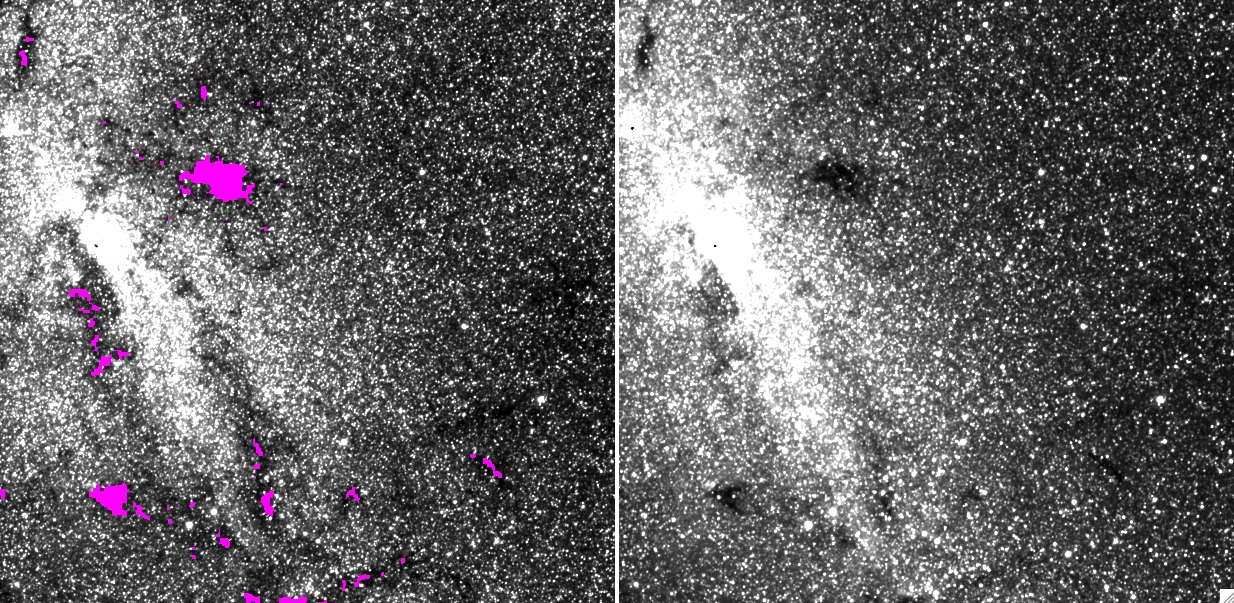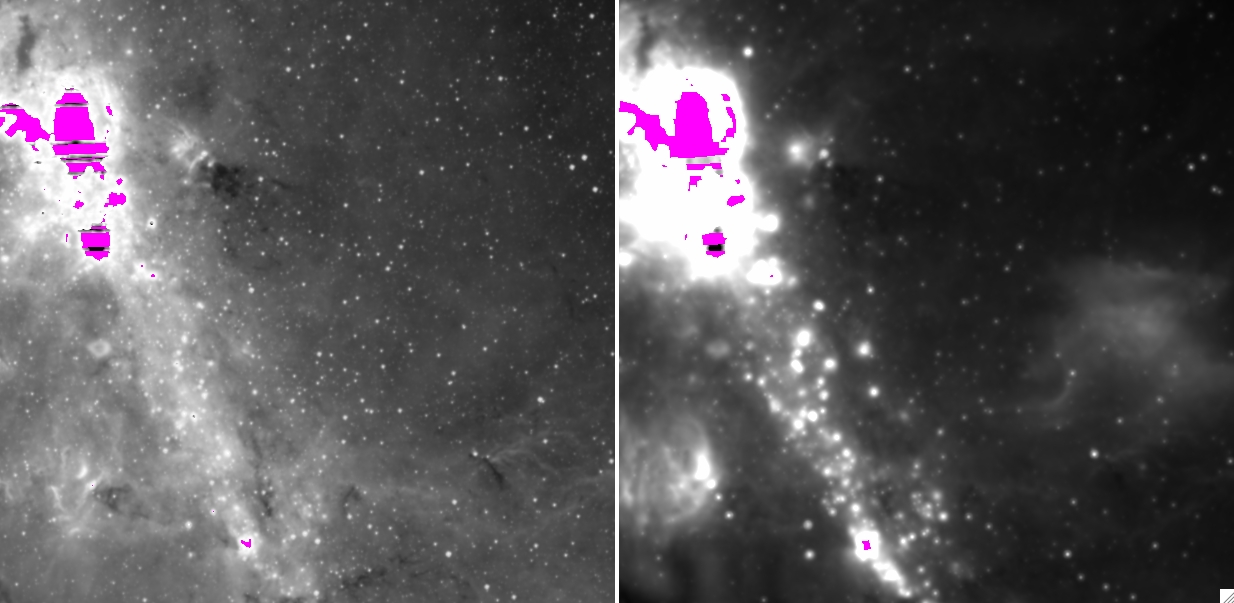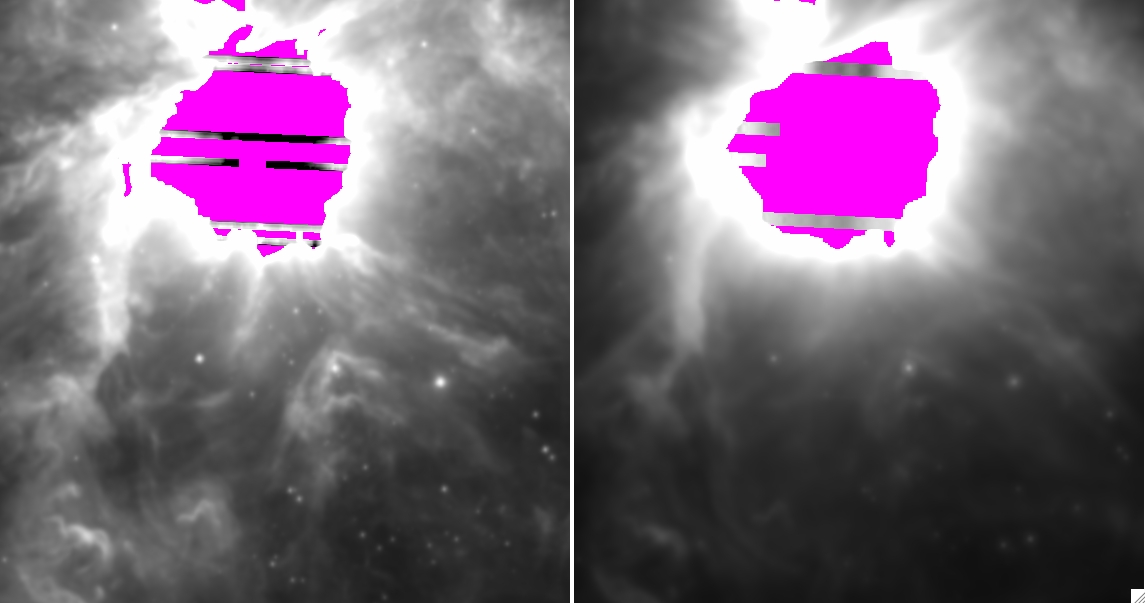


I. Introduction
4. Cautionary Notes
c. Image Atlas
Contents
- Depth-of-Coverage Variations
- Low Coverage Areas
- Astrometric Bias with Respect to Source Catalog
- The intensity units of Atlas Image pixels are Digital Numbers (DN)—Photometric Calibration
- Background (frame-overlap) Matching
- Atlas Image Artifacts
- Saturation
- Missed (Unmasked) Saturation
- Over-tagging of Outliers in Complex Regions
- Low-flux Banding Artifacts
- Effective Size of a "point-source" in an Atlas Image
i. Depth-of-Coverage Variations
Global and local variations in the depth-of-coverage are expected from the
nominal survey design (section VI.2).
However, there are regions where the depth-of-coverage varies considerably
due to the exclusion of "bad" input frames and individual
pixels when generating the Image Atlas.
This could be due to
contamination from the moon, cosmic rays,
and/or other outliers (e.g., induced by fast moving objects),
or bad quality frames in general. The latter
are usually associated with elevated noise or degraded image quality
caused by excursions in
spacecraft tracking. For details on the frame selection process, see section
V.2.c. A general description of the
construction of the depth-of-coverage maps and the physical meaning of
pixel values therein is given in section
II.3.d.
ii. Low Coverage Areas
Examples of Atlas Images with low depth-of-coverage
are shown in section
VI.2.c.
An immediate consequence for regions with low depth-of-coverage
(covered effectively <~ 6 times) is
that the
temporal pixel-outlier rejection
process becomes unreliable.
Even though robust estimators were used in this method,
they are still relatively "noisy" when
the number of samples in the stack was low.
Strictly speaking, no temporal
pixel-outlier rejection is performed for depths-of-coverage ≤ 4.
This criterion avoided throwing away too many good pixels during the
coaddition process, with the caveat of increasing the number
of unreliable or spurious detections (cosmic rays, fast moving object trails,
and other transients).
Note that the Source Catalog selection process
explicitly excluded
extractions from regions with a depth-of-coverage ≤ 4.
iii. Astrometric Bias with Respect to Source Catalog
If one were to measure the equatorial (J2000) positions of sources
off Atlas Images, e.g., via a flux-weighted centroid or peak-finding algorithm,
there could be a systematic difference with
the astrometrically calibrated
positions from the WISE Source Catalog.
The latter was calibrated with respect to 2MASS to an accuracy of <~
0.4 arcsec over the sky
(section VI.4).
For reasons not yet understood, the absolute (radial) differences between
Atlas Image-derived source peaks and "true" astrometric positions vary with
location on the sky and are typically
<~ 0.25 arcsec for bands 1 and 2, and <~ 1.2
arcsec for bands 3 and 4 (90th percentile upper limits).
A procedure to correct the Atlas Image-derived
source positions and/or image WCS
in general (if significant biases exist) is given in
section II.3.g.
iv. The intensity units of Atlas Image pixels are Digital Numbers (DN)
Pixel units in the Atlas Images (and single-exposure images) are
not calibrated in terms of absolute surface brightness. Their units are
digital numbers (DN). The images are designed for photometric
measurements relative to a local background using the photometric
Zero Point Magnitude (MAGZP) provided in their
FITS headers.
Section II.3.f describes how the Atlas Image
DN values (and measurements derived therefrom in DN)
can be converted to absolute flux units.
v. Background (frame-overlap) Matching
One of the first steps in the Atlas
Image generation pipeline is
background level matching of the
single-exposure frames.
Since WISE had no requirements for measuring the
absolute intensity of the background,
we adopted a simple, fast, locally self-consistent method. Only the single
exposure frames touching an individual Atlas Image tile (independent of all
those touching neighboring tiles) were matched with respect to each other.
Two caveats of this method are:
- Background gradients and levels
will not be continuous across Atlas tile boundaries on the sky.
I.e., systematic "step-like" patterns will result if one attempts to
stitch together several or more tiles across the sky.
- Within an
individual tile, the method assumes the difference in levels in the
overlap region between any pair of frames is spatially constant.
This is usually a good approximation,
however, it breaks down when the background
gradient is not the same across frames in their overlap
region (i.e., that "see" the same piece of sky).
This usually occurs when the frames are contaminated
by scattered moon-light and results in step-like patterns across
frame boundaries in an Atlas Image.
vi. Atlas Image Artifacts
The Anomaly Gallery
contains examples of the artifacts
commonly encountered in Atlas Images.
Overall, these fall in two broad categories, with much overlap between
the two:
- Artifacts present at the single-exposure level that
are not suppressed during the co-addition process. Examples are
diffraction spikes and short-term latents.
The survey scanning strategy
in general did not produce randomly dithered overlapping
frames for optimal pixel
outlier detection.
Due to negligible frame rotation
around the ecliptic plane, these artifacts are seen to
reinforce most strongly there, while
they "smear-out" as one approaches the ecliptic poles.
- Transients that are most apparent
in low depth-of-coverage regions, e.g.,
cosmic rays, detector-induced
electronic-noise (channel/amplifier noise
in bands 1 & 2
or droop residuals in bands 3 & 4), light scattered from the moon
and other bright objects, glints, satellite trails, fast moving objects, and
latents generated therefrom.
vii. Saturation
Saturated pixels are masked in the single exposure frames and omitted
when constructing the Atlas Images.
For bright regions and sources exceeding
the saturation limits,
pixels in the Atlas Image
intensity and uncertainty maps will be associated with NaN
(Not-a-Number) values.
The corresponding depth-of-coverage map will have zero coverage in these
regions. These "holes" are typically seen at the location of the peak-emission
of sources. An example is shown here.
viii. Missed (Unmasked) Saturation
The automatic saturation tagging
that occurred on board the WISE spacecraft worked rather well,
however, there were times when it was not reliable.
This occurred intermittently when the counts were at the highest end of the
dynamic range in any band. Hence, there are instances in regions
of very bright emission, including the cores of very bright sources
where saturated frame pixels (with anomalous values)
were included when constructing
the Atlas Images. The values of these pixels are generally low relative to
that expected for the region. An example is shown in
Figure 1 and it is generally seen in all bands.
Given that the single exposures were also affected and used for
simultaneous PSF-fit photometry, the impact
on the catalog photometry is described in section
I.4.b.
ix. Over-tagging of Outliers in Complex Regions
In regions with complex emission or a fast spatially-varying
background (e.g., parts of the galactic plane),
pixels may be erroneously tagged as
outliers across a stack of input frames by the
pixel-outlier rejection step.
This results in sporadic holes (NaNs) in the Atlas Images,
particularly in bands W1 and W2 (e.g., Figure 1).
This is caused by the large variance in the background levels
within frame-overlap regions.
For details, see the last paragraph in
section IV.4.f.3.
The number of tagged outliers is further inflated by the
outlier-expansion step (intended for moving
object mitigation) since this is triggered when the spatial density of outliers
exceeds some threshold. One set of outlier detection/expansion
parameters were used for the entire sky for each band.
Given the heterogeneous nature of the survey, there's no
guarantee this parameter set produced consistent results throughout.
 |
 |
| Figure 1 - Atlas Image cutouts near the galactic center:
bands W1, W2, W3, W4 - top left, top right, bottom
left, and bottom right respectively.
Magenta regions represent
NaN'd (zero-coverage) regions. W1 shows an example of the
outlier-overtagging anomaly
(NaNs at otherwise genuine depressions in the emission);
W3 and W4 show examples of the impact of including frame
pixels which were not masked for saturation
(dark depressions meshed with NaN'd regions properly
masked for saturation). |
x. Low-flux Banding Artifacts
In regions with very-bright emission, W3 and W4 Atlas Images often show
banding patterns with depressed flux. The regions need not be saturated
or close to saturation. This effect is due to inadvertently unmasked
pixel rows at the top and bottom edges of the input W3 and W4
single-exposure frames that have a relatively low
responsivity. These low-response rows were not completely captured in the
static flat-field calibration products to enable their removal since their
responsivity was slightly transient.
Given that the low-response pixel rows
have a multiplicative effect on the signal
that falls on them, higher signals will suffer a
proportionally greater loss in their output counts. These
anomalously low counts fall below
the detector saturation thresholds and therefore remain unmasked.
This banding effect is seen in the bright regions
of the W3 and W4 Atlas Image-cutouts shown in Figures 1 and 2.
Note that the flux along a "band" could be depressed by as much as 12%
over the entire length of the band spanning an Atlas Image.
Therefore, all sources or emission intercepting such bands are likely
to have a biased flux.
 |
| Figure 2 - Atlas Image cutouts showing the core of the
Orion Nebula, left: W3; right: W4. Magenta regions
represent NaN'd (zero-coverage) regions due to
saturation in all the input frames at that location.
See section I.4.c.x. for details. |
xi. Effective Size of a "point-source" in an Atlas Image
The effective size of the PSF in an Atlas Image is not the same as that
inferred from the single-exposure frames. For the latter,
the azimuthally-averaged FWHM of a point source profile
is ≈ 5.8″, 6.4″, 6.7″, and 11.8″
for bands W1, W2, W3, and W4 respectively
(e.g., see Table 1 in section
IV.4.c.iii.1).
For Atlas Image (co-adds) however, the FWHM of a point source profile
is ≈ √2 times larger than the native (single-exposure) values,
or ≈ 8.3″, 9.1″, 9.5″, and 16.8″
in W1, W2, W3, and W4 respectively (however, see caveat below).
This additional smoothing arises from use of the native PSF
as an interpolation kernel during the co-addition process
(for details, see section IV.4.f.vii).
This includes the small inevitable amount of smoothing from
mapping onto a new grid with finite-sized pixels.
The PSF-interpolation makes the Atlas Images also serve as
match-filtered products optimized for detecting sources in the pipeline
(for details, see section IV.4.b).
The Atlas Image PSF FWHMs quoted above
are global ballpark measures and not representative of any one Atlas Image.
A "highly-homogenised" set of Atlas Image PSFs is provided in section
IV.4.c.viii. These were created
from Atlas Images at high ecliptic latitudes where the
high depth-of-coverage and large spread in
single-exposure rotations acted to circularize the PSF.
Owing to the asymmetric nature of the native PSFs (even after co-addition
for low-to-moderate depths-of-coverage),
we recommended you derive the PSF for your
Atlas Image of interest. To obtain an accurate PSF, you may need to
combine measurements from multiple Atlas Images with similar
depths-of-coverage and input single-exposure geometries.
Last update: 2012 May 15








